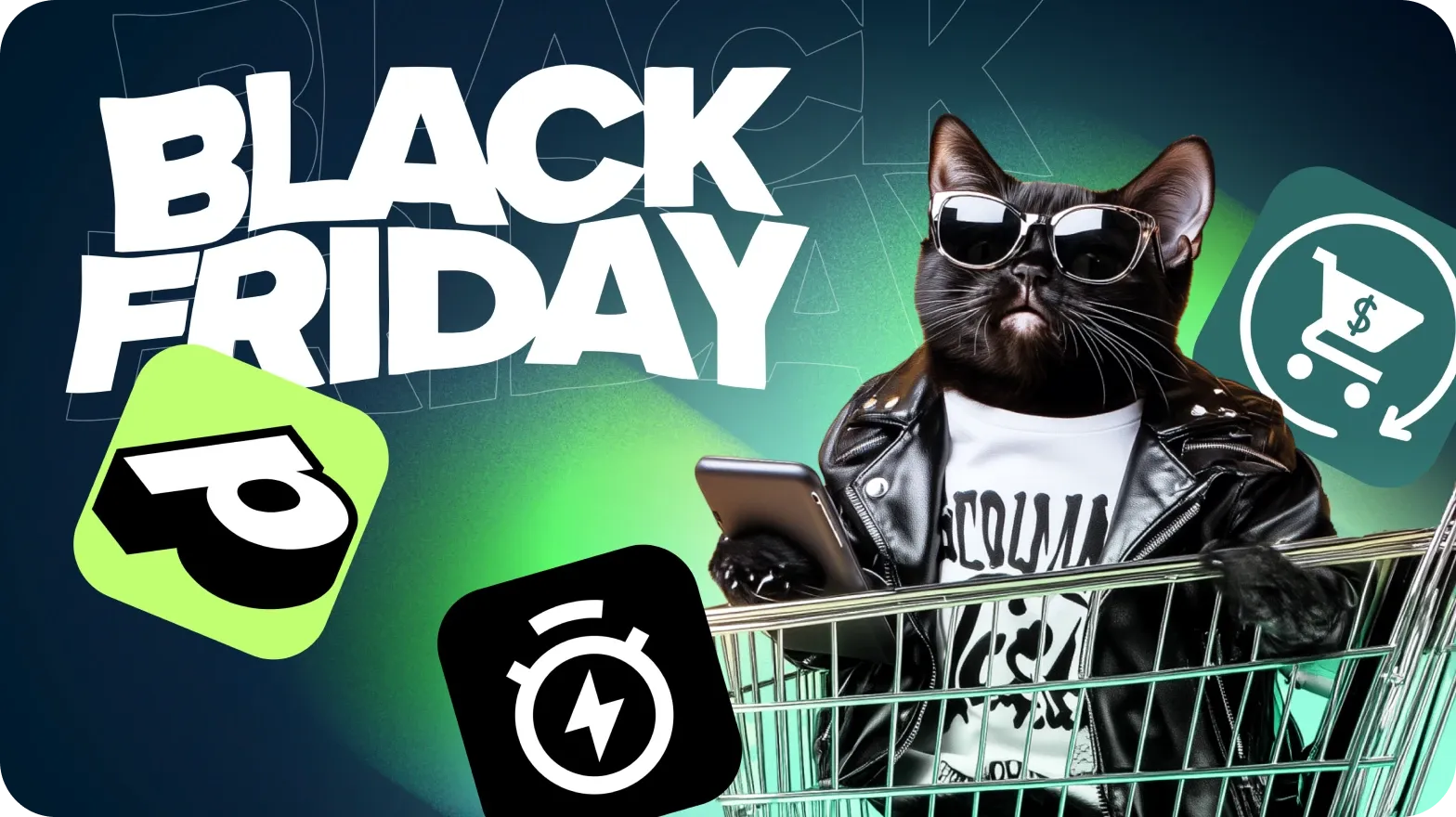
The Christmas holiday shopping season hits earlier every year – and winning it takes more than last-minute discounts. You need:
fast pages,
a flawless checkout,
reliable integrations,
smart inventory planning,
clear shipping deadlines,
and marketing that's ready before December.
Instead of a vague "ecommerce holiday readiness" pep talk, this guide gives you a structured roadmap covering everything from technical prep to customer support, so you can tackle Christmas sales confidently, efficiently, and without the seasonal panic.
Why you should start your preparation now
Christmas preparation in ecommerce isn't a two-week sprint. It may be a months-long process and require coordination across multiple parts of your business. In short, there are several reasons to start as early as possible:
Scope of work. Many people and functions are involved to create the best experience, from ecommerce developers and the support team to suppliers and multiple third-party services. Rush any part, and something will break when you can least afford it.
Dates shifting. Influencers start Christmas marketing earlier each year, trying to fit in the ads and offers into their content schedule. Retail brands have no other option but to follow. We bet you won't be very much surprised to notice Christmas attributes in November or even October, that's the reality these days.
Competitors. Your rivals aren't waiting until the last minute either – at least, not all of them. And you certainly want to be among the proactive ones. The store that captures customers' attention earlier has a massive advantage over the one that shows up in mid-December.
Flexibility. Starting now gives you something invaluable – options. You can test different approaches, fix what doesn't work, and optimize what does so it works even better. Wait until the last minute, and you're stuck with whatever you can pull together under pressure.
But there's a silver lining. Even if you have to start preparation for the holiday shopping season late, working systematically is still better than winging it. Even if not perfect, everything will be ready for the Christmas shopping in case you find the right roadmap. That's what we're about to share.
How to prepare your online store for the Christmas rush: The checklist
What you need is a systematic approach that covers every critical area of your business. We break down Christmas preparation into manageable sections: things to do before, during, and after the Christmas shopping season. It covers both technical and operational details, since each area directly impacts your ability to convert traffic into revenue.
Maybe not every item among these tips for Christmas in ecommerce will apply to your specific store, and that's fine. Use what looks relevant and applicable, but without skipping sections just because they seem tedious or technical. Let's get into it.
Before Christmas sales
This part of the preparations focuses mostly on the technical side of your store. So, here are some tips to prepare the website for holiday shoppers, as well as to get holiday ecommerce marketing materials and your support team ready.
#1 Optimize your website's speed
Run tests that simulate hundreds of simultaneous users adding items to carts and checking out. If pages start lagging or timing out, that's a breaking point that needs fixing. It's best to make a page load in three seconds or less. For this, remove unnecessary plugins, compress images, and enable browser caching.
Is Shopify your ecommerce platform? Check practical Shopify speed optimization tips – we've listed them in our detailed article about how to speed up the Shopify store, covering the most essential approaches, along with advanced ones. If you need help to speed up your store, opt for our Shopify speed optimization services.
#2 Audit the checkout
Walk through your entire checkout flow as if you're a first-time customer. Count how many clicks it takes to complete a purchase and minimize them if possible. Consider removing mandatory account creation and enabling guest checkout. Also, cut unnecessary form fields. Your goal is to ensure a user can get from "Add to cart" to "Order complete" in as few steps as possible.
If you have a Shopify-based store, check out our full guide to effective Shopify checkout optimization to turn browsers into buyers and boost sales with every click.
#3 Audit the mobile version
Consumers now use mobile phones more than any other device for online shopping.
Mobile retail commerce sales statistics by Cropink.
In other words, your mobile site needs to work perfectly. If you haven't ensured it yet, do include this point in your Christmas sale preparation plan. Test on actual devices, check UI carefully, pay attention to usability, and don't forget about performance.
#4 Audit the add-ons
Review third-party integrations – payment gateways, shipping calculators, marketing extensions, etc. Make sure everything's up to date and compatible. The last thing you need is a plugin conflict crashing your site during heavy traffic. If something's outdated or causing issues, fix it or replace it now.
If you're running a Shopify store, read our article to check the most necessary integrations for your Shopify store.
#5 Analyze the demand
Review last year's sales data to identify your bestsellers during the holiday period. Account for growth and current ecommerce holiday trends, too. If your traffic increased this year, your inventory needs should reflect that. Next, reach out to suppliers in advance to confirm lead times, minimum order quantities, potential delays, and other technicalities. Build buffer time into your ordering schedule to feel more secure.
#6 Communicate the shipping dates
Nothing frustrates people more than ordering a Christmas gift that arrives in January. Thus, customers need to know the latest date they can order items to get them in time. Work backward from December 25th, accounting for processing time and carrier schedules, and display these dates. Make them stand out visually on your homepage, product pages, and checkout.
Example of a holiday shipping deadlines popup
#7 Clarify the return policy
More intensive shopping means more returns. And that's okay. Sometimes, we buy gifts that don't fit, aren't the right color, or simply aren't wanted. Just make your return policy clear and easy to find, and specify the details: return window, who pays shipping, and what conditions items must be in.
#8 Plan your promos
As developers prepare your website for holiday shoppers, marketing is to do its part. Map out every sale, discount, and campaign from November through December. Knowing what you're running and when prevents overlapping campaigns that confuse customers or cannibalize each other's effectiveness.
#9 Prepare content in advance
Build email sequences for cart abandonment, post-purchase follow-ups, and promotional announcements. Update your product descriptions to highlight gift-worthiness. Mention occasions, suggest pairings, emphasize presentation. Create gift guidelines and your own Christmas preparation tips. Prepare festive visuals, including banners, social media graphics, and more. These little things also increase conversions.
You can learn about more marketing tips for the Holiday season in our dedicated article. Also, you might be interested in the list of free and paid Shopify AI tools that can be used to speed up some tasks, such as creating product descriptions, launching marketing campaigns, etc.
#10 Set up retargeting campaigns
Holiday shoppers browse multiple sites before buying. Keep it in mind during ecommerce holiday planning. Retargeting ads remind them you exist when they're ready to purchase. Set up campaigns early so they launch when traffic starts increasing. Focus on people who viewed products but didn't buy them, or those who abandoned their carts.
#11 Highlight customer service options
Make it obvious how people can reach out to you – email, chat, phone, whatever you offer. If necessary, consider extending support hours for the pre-holiday season. It's the same thing that happens with returns: when order volumes spike, so do customer questions.
#12 Review your FAQs
Write answers to questions you know you'll get repeatedly. It makes sense to explain everything related to shipping times, return policies, gift wrapping availability, and order tracking. Put this information where it's easy to find. Every point in an FAQ section is one less message in the support inbox.
During Christmas sales
This is the stage where most of the work happens. You are to address operations management and potential adjustments in ecommerce holiday marketing and customer service routines.
#13 Monitor site performance
Check your analytics daily. Load times, conversion rates, traffic sources – make sure nothing's breaking. Small issues caught early are easy fixes. Small issues discovered three days later are revenue lost.
#14 Watch inventory levels
You certainly don't want to sell products you can't actually ship! Set up low-stock alerts for bestsellers so you know when to reorder or take items off promotion. Update "Out of stock" status immediately when items sell out.
Example of "NOTIFY ME WHEN IN STOCK" feature on our client's site, Koio
#15 Adjust marketing spend
Flexibility is one of the key holiday ecommerce tips. You may need to change some tactics on the go, and December is expensive for advertising. So, don't waste the budget on campaigns that aren't delivering. Keep a close look at performance. If certain ads or channels are converting well, allocate more budget there. If something's not working, cut it and redirect the money.
#16 Communicate shipping proactively
Send order confirmations immediately. Provide tracking numbers as soon as items ship. If there are delays, tell customers before they have to ask. It all helps prevent shipping-related complaints and extra questions to your support team.
An example of an order shipping confirmation email by Nike
#17 Promote urgency
Urgency works; yet, it has to be real. So do it appropriately. Fake scarcity erodes trust. Use it honestly when inventory is actually low or shipping deadlines are genuinely approaching. In terms of ecommerce web design, make it visible but not overwhelming. In the end, you sell products, not threats. If you use flash sales, do it to move specific inventory or drive urgency during slower days.
#18 Offer last-minute gifts
After the last shipping cutoff for physical products, shift focus to digital gift cards or instant-delivery items. Customers still need last-minute gifts. That's where you facilitate Christmas preparation for the busy ones. Make it easy for them to buy something that arrives immediately.
#19 Prepare to solve issues quickly
Aim to respond faster than usual. Holiday shoppers are impatient because they have deadlines. Prepare for common issues, like an incorrect address entered or tracking showing delays. Have templates ready for the most frequent problems and personalize where needed. Give customer service staff authority to issue refunds, expedite shipping, or offer discounts without manager approval for every decision. Develop a clear framework instead.
After Christmas sales
The work doesn't stop when Christmas Eve comes. It's useful to gradually shift to post-holiday promotions. Also, there's a chance you may need to handle returns. And you need to analyze everything to perform better next year.
#20 Clear the remaining inventory
People may stay in a buying mode for a while. Post-holiday ecommerce sales can capture customers who are spending gift cards or taking advantage of their own post-Christmas budgets. Meanwhile, discounts on seasonal items move stock that won't sell as well in January. Moving inventory, even at reduced margins, is often worth it.
#21 Manage returns strategically
For example, if someone returns a gift, that's an opportunity. Offer to help them find something they'd prefer. Provide a discount on their next purchase. Turn an order return into a relationship. Set up the entire return process and refunds to be as quick as possible to make a good impression. It can help you win clients and boost your sales in the future.
Promocode instead of a refund example by Walmart
#22 Review the results
Conclude what worked and what didn't. This data informs next year's holiday ecommerce strategy, so document it while it's fresh. Calculate actual ecommerce ROI on campaigns. Look at what you spent versus what you earned across all channels – ads, email, social media. Document operational issues. Analyze customer feedback. Read reviews, survey responses, and support tickets.
#23 Thank your team
Let's wrap up the holiday selling ecommerce tips with some gratitude: acknowledge your staff's hard work. Holiday retail is exhausting. Appreciation is deserved and important for morale and retention.
Get ready for Christmas with DigitalSuits
Yes, there's a lot to do. But now you have a structured plan to achieve holiday readiness. You know what needs attention first, what can wait, and what actually drives results versus what just feels busy. If you suspect that your team lacks the technical expertise to do it all quickly and efficiently, don't hesitate to reach out to DigitalSuits.
Our ecommerce web development company specializes in building and optimizing shopping platforms – and ecommerce store preparation for the holidays, among other things. We will help you ensure performance under heavy traffic, optimize checkout flows, set up landing pages, connect the right apps, and more. Don;t let technical limitations cost you sales this Christmas.
Frequently asked questions
How do I know if my website can handle a Christmas traffic increase?
Most hosting providers offer load testing tools, or you can use external services to simulate traffic spikes. As for the number of users, the simplest approach is to look at your analytics. Take the number of visitors from last year's peak day and multiply that traffic by 1.5 to 2x as a safety buffer. If pages load in under 2-3 seconds, you're safe.
Is it safe to install new apps or plugins in November?
It depends on what you're installing and how critical it is. Adding a simple countdown timer or holiday banner is fine. Installing a new payment gateway or completely revamping your product pages isn't the best idea. The rule of thumb: if the plugin touches checkout, inventory, or core site functionality, wait until January unless it's fixing a critical problem.







































Was this helpful?
0
No comments yet